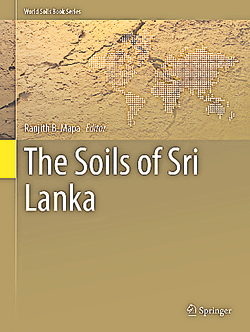Filling an important void in these days of environment degradation
 The Soils of Sri Lanka edited by Prof. Ranjith B. Mapa, one of the prominent soil scientists in the country provides current information on local soils and is now published as a World Soils Book series by Springer International. Dedicated to Vidya Jothi C.R. Panabokke who pioneered in mapping the soils of Sri Lanka, the book consists of chapters on Soil Research and Soil Mapping History, Climate, Geology and Geo-morphology, Soil Mineralogy, Classification and Mapping of Soils of Wet, Intermediate and Dry Zones, Land Use, Soil Degradation and Environmental Soil Issues authored by the experts in respective fields with 128 pages, 38 black and white illustrations and 59 colour plates.
The Soils of Sri Lanka edited by Prof. Ranjith B. Mapa, one of the prominent soil scientists in the country provides current information on local soils and is now published as a World Soils Book series by Springer International. Dedicated to Vidya Jothi C.R. Panabokke who pioneered in mapping the soils of Sri Lanka, the book consists of chapters on Soil Research and Soil Mapping History, Climate, Geology and Geo-morphology, Soil Mineralogy, Classification and Mapping of Soils of Wet, Intermediate and Dry Zones, Land Use, Soil Degradation and Environmental Soil Issues authored by the experts in respective fields with 128 pages, 38 black and white illustrations and 59 colour plates.The chapter on Soil Research and Soil Mapping history describes the landmarks of the history of Soil Science in Sri Lanka during the early (prior to 1956), middle (1956-1972) and present (from 1972 to present) periods including the soil maps produced by the father of Soil Science, Dr. A.W.R. Joachim and subsequently improved by Kingsley de Alwis and C.R. Panabokke. It also describes how the soil classification of Sri Lanka developed starting from Great Soil Groups to international methods.
The chapter on the Climate of Sri Lanka authored by Dr. B.V.R.Punyawardena highlights the distribution of major climatic factors as rainfall, temperature, relative humidity and evaporation. The principles used in naming the major climatic zones to Wet, Intermediate and Dry zones are described. Subsequently, with the availability of data these were revised to Agro-climatic Zones and presently to Agro-ecological regions, which has become the planning unit for agriculture.
Chapter three is on Geology and Geomorphology of the country by Prof. Rohana Chandrajith. Even though the country is small, the complexity of geomorphology is discussed using height and slopes dividing the island to peneplains as coastal lowlands, uplands and highlands. Colour plates and sketches showing these peneplains are included in the chapter. The geology is important as the soils are formed from rocks which weather into parent material. The Highland, Vijayan and Wanni complexes are discussed showing their occurrence in the country using colour plates. In addition the sedimentary rocks in the northern region and Jurassic beds found in Tabbowa and Andigama areas in the northwestern part of the island are discussed.
Knowledge on the mineralogy of the soils of Sri Lanka is limited and Chapter four authored by Prof. Srimathi. P. Indaratne fulfils this need. The different types of clay minerals found in tropical countries as Sri Lanka and using the clay mineralogy to understand the weathering stages are discussed. The mineralogy of the Wet, Intermediate and Dry zones are discussed providing an excellent literature review and x-ray diffractograms also showing examples of identifying major clay minerals as kaolinite, smactite, illite etc. Finally, the chapter summarizes how soil mineralogical properties influence the pollutant behaviour in soils.
Chapters five, six and seven are authored by A.R. Dassanayake and others, describing the major characters and classifying the Wet, Intermediate and Dry zones of Sri Lanka. These are grouped into major categories for easy understanding. The soils of the Wet and Intermediate zones are described using the Agro-climatic zones where the rainfall and elevation is considered.
One sheet of the soil maps are published as colour plates providing information on how to locate the complete detailed soil maps from literature. The classification of soils used in the 1972 classification by de Alwis and Panabokke, as well as their equivalents in Soil Taxonomy (USDA) and WRB-FAO legend are included. Soil names of these updated international classifications are needed when publishing in recognized journals elsewhere. A colour plate showing the landscape and soil profile of each soil series is included for easy identification by the reader. All the soil data used to write these chapters could be downloaded from Elsevier as first 3-D soil database of Sri Lanka from “https://data.mendeley.com/datasets/5sc7njfcyn/1”
Chapter eight covers the Land Use in Sri Lanka outlining information on major land use systems including rice, plantation crops, forestry etc. and changes in such land uses. The legislation related to land, land tenure issues and landlessness which leads to encroachment of state lands is discussed. The need for sound land use planning for the future is highlighted.
Chapter nine covering soil degradation by Dr. H.B. Nayakekorale outlines the human induced land degradation processes and ways of overcoming them. The need to bring in legislative measures to combat land degradation in the country is highlighted in this chapter.
The final chapter addresses the environmental soil issues of the country. The release of trace elements from lithogenic and anthropogenic activities and use of low quality chemical fertilizers and pesticides is discussed. The quality of surface and ground water of the country depends on the agricultural inputs added to soils and the future research needs to combat such pollution of water resources is highlighted.
Soils of Sri Lanka fills a gap in knowledge on soils as well as related factors that deal with soil formation and management.
(The reviewer is Emeritus Professor, University of Peradeniya)



